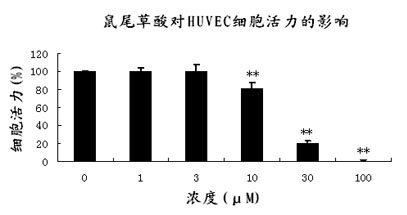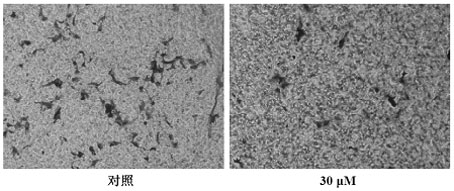Application of carnosic acid in preparing medicament for suppressing angiogenesis
An angiogenesis and carnosic acid technology, applied in drug combinations, cardiovascular system diseases, anti-tumor drugs, etc., to achieve the effect of inhibiting tubule formation
- Summary
- Abstract
- Description
- Claims
- Application Information
AI Technical Summary
Problems solved by technology
Method used
Image
Examples
Embodiment 1
[0030] Example 1 Carnosic acid inhibits the proliferation of human umbilical vein endothelial cells (HUVEC)
[0031] The proliferation of HUVEC was detected by CCK-8 method. CCK-8 reagent contains WST–8 (2-(2-methoxy-4-nitrophenyl)-3-(4-nitrophenyl)-5-(2,4-disulfonic acid benzene) -2H-tetrazolium monosodium salt), which is reduced by the dehydrogenase in the mitochondria of the cell under the action of the electron carrier 1-Methoxy PMS (1-methoxy-5-methylphenazine dimethyl sulfate) to have Highly water-soluble yellow formazan (Formazan) product. The amount of formazan produced is directly proportional to the number of viable cells. The light absorption value was measured at a wavelength of 450 nm by an enzyme-linked immunosorbent detector, which can indirectly reflect the number of living cells. The effect of drugs on the proliferation of HUVCE can be evaluated by this method.
[0032] Methods: HUVEC cells were seeded in 96-well plates and cultured. After the cell grow...
Embodiment 2
[0036] Example 2 Carnosic acid inhibits the migration of human umbilical vein endothelial cells (HUVEC)
[0037] Transwell method was used to detect HUVEC migration. Transwell is an experimental technology. The main material of this technology is the Transwell chamber (chamber). The bottom layer of the chamber has a layer of permeable membrane (polycarbonate membrane (polycarbonate membrane) is commonly used, and this membrane has pores. Micropores with a size of 0.1-12.0 μm. In the experiment, the cells are placed on the small chamber. Under the action of the chemokines or growth factors contained in the small chamber, the cells pass through the polycarbonate membrane, thereby performing co-culture, cell chemotaxis, cell Migration, cell invasion and many other studies.
[0038] Method: Add 600 μL of VEGF containing 20 ng / ml to the lower chamber 165 HUVEC culture medium. HUVEC containing different concentrations of carnosic acid were added to the upper chamber (the cell d...
Embodiment 3
[0040] Example 3 Carnosic acid inhibits HUVEC tubule formation experiment
[0041] The tubule formation of HUVEC was detected by Matrigel gel. Artificial basement membrane Matrigel is a basement membrane component extracted from mouse EHS sarcoma. It can spontaneously form a gel-like artificial basement membrane at 37 °C, and has the biological function of a natural basement membrane. Human umbilical vein endothelial cells can adhere to form tubes on Matrigel glue, which can be used to study the effect of drugs on the tube formation of endothelial cells.
[0042] Method: 50 μl of Matrigel gel solution was added to a pre-cooled 96-well culture plate, and then placed in a 37 °C incubator for 1 h to solidify the gel. Add HUVECs (cell density 1×105 / ml) containing different concentrations of carnosic acid into Matrigel-coated 96-well plates and place in CO 2 Incubate for 10 h in the cell culture incubator. The group without carnosic acid was used as the control. After 10 h, b...
PUM
 Login to View More
Login to View More Abstract
Description
Claims
Application Information
 Login to View More
Login to View More - R&D
- Intellectual Property
- Life Sciences
- Materials
- Tech Scout
- Unparalleled Data Quality
- Higher Quality Content
- 60% Fewer Hallucinations
Browse by: Latest US Patents, China's latest patents, Technical Efficacy Thesaurus, Application Domain, Technology Topic, Popular Technical Reports.
© 2025 PatSnap. All rights reserved.Legal|Privacy policy|Modern Slavery Act Transparency Statement|Sitemap|About US| Contact US: help@patsnap.com



